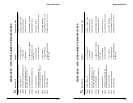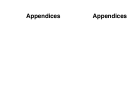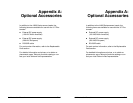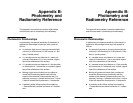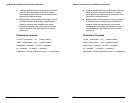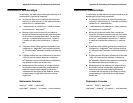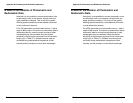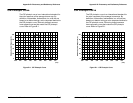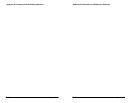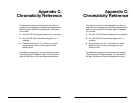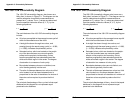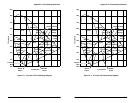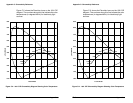
Appendix B: Photometry and Radiometry Reference
J17 Instruction Manual
B-3
Radiometric Relationships
In radiometry, an ideal sensor has equal sensitivity to all
wavelengths of light being measured.
H An isotropic light source (a source that emits light
uniformly in all directions) of 12.6 watts produces a
radiant flux of 1 watt/steradian.
H 1 watt/steradian at a distance of 1 meter produces
an irradiance of 1 watt/meter
2
.
H Moving a light source further from a surface reĆ
duces the irradiance proportionally with the square
of the distance (inverse square law). For example,
moving a 1 watt/steradian source from 1 meter to
2 meters will reduce the irradiance to ¼ watt/meĆ
ter
2
.
H A perfectly white, diffuse surface illuminated by an
irradiance of 1 watt/meter
2
has a surface radiance
of .318 watt/meter
2
/steradian (irradiance divided by
p).
H A diffuse surface that has a reflectance of less than
100% will have a surface radiance, in watts/meĆ
ter
2
/steradian, equal to the irradiance multiplied by
the reflectance factor and divided by p.
H Measurement of the radiance of a large uniformly
illuminated surface is essentially independent of
distance, since the area viewed by the sensor
increases with the square of the distance, exactly
compensating for light falloff due to the inverse
square law.
Radiometric Formulas
wattńcm
2
@ 10000 + wattńmeter
2
wattńmeter
2
@ distance
2
ĂĂ(inĂ meters) + wattństeradian
Appendix B: Photometry and Radiometry Reference
J17 Instruction Manual
B-3
Radiometric Relationships
In radiometry, an ideal sensor has equal sensitivity to all
wavelengths of light being measured.
H An isotropic light source (a source that emits light
uniformly in all directions) of 12.6 watts produces a
radiant flux of 1 watt/steradian.
H 1 watt/steradian at a distance of 1 meter produces
an irradiance of 1 watt/meter
2
.
H Moving a light source further from a surface reĆ
duces the irradiance proportionally with the square
of the distance (inverse square law). For example,
moving a 1 watt/steradian source from 1 meter to
2 meters will reduce the irradiance to ¼ watt/meĆ
ter
2
.
H A perfectly white, diffuse surface illuminated by an
irradiance of 1 watt/meter
2
has a surface radiance
of .318 watt/meter
2
/steradian (irradiance divided by
p).
H A diffuse surface that has a reflectance of less than
100% will have a surface radiance, in watts/meĆ
ter
2
/steradian, equal to the irradiance multiplied by
the reflectance factor and divided by p.
H Measurement of the radiance of a large uniformly
illuminated surface is essentially independent of
distance, since the area viewed by the sensor
increases with the square of the distance, exactly
compensating for light falloff due to the inverse
square law.
Radiometric Formulas
wattńcm
2
@ 10000 + wattńmeter
2
wattńmeter
2
@ distance
2
ĂĂ(inĂ meters) + wattństeradian



